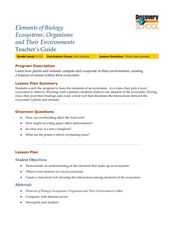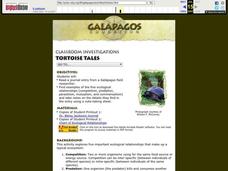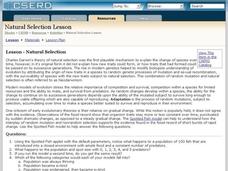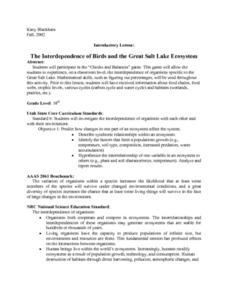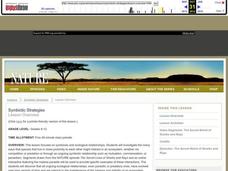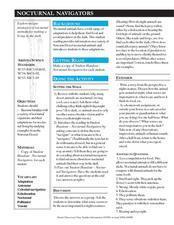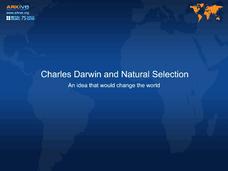Curated OER
Biology: living Things and their Environment
Students recognize that organisms depend on other organisms. For this organism lesson, students understand symbiotic relationships and competition. Students explain food chains and food webs. Students understand that...
Curated OER
Population Growth
Students grow duckweed, observe what happens when an organism population is allowed to grow without predation or competition, view videos about invasive species, and develop a proposal for controlling the growth of an invasive species in...
Curated OER
Bioinvasion
Young scholars examine the role of organisms when they eliminate the native species of an area. They review cooperative and competitive relationships within an ecosystem.
McGraw Hill
Arthropods
Are spiders related to crabs? Study the order of arthropods with a reading selection about animal diversity. It provides details about each class within the order, as well as vivid pictures and explanatory charts.
Curated OER
Organisms and Their Environments
Learners study a local ecosystem and research the organisms to create a food web. In this ecosystem activity, students view a video and answer questions. They visit a local ecosystem and make a list of organisms to research. Learners...
Curated OER
Tortoise Tales
Students read journal entry from a Gal??pagos field researcher, find examples of five ecological relationships (competition, predation, parasitism, mutualism, and commensalism) and take notes on the details they find in the entry using a...
Curated OER
Raptor Force
Students observe a video about pilots, their desired traits, and explore the similarities between a bird and an airplane. Using paper, wood or foam, they design create an aircraft to be flown in a competition to see which plane will fly...
EngageNY
Close Read: Epiphytes of the Rainforest and the Creatures That Call Them Home (Pages 24–26)
It's all connected. Scholars use pages 24-26 of The Most Beautiful Roof in the World to identify the relationship between the plants and animals in the rainforest. They answer and discuss questions about the relationship with a...
Curated OER
Biology: Natural Selection
Students explore evolutionary processes and theories using the spotted fish applet. They observe what happens to fish in a closed environment with both food and predators. Students run the model several times and answer questions about...
Kentucky School for the Deaf
Levels of Organization within an Ecosystem
From tiny organisms to entire biomes, young scientists examine the interdependent relationships tying all living and non-living things together with this collection of ecology resources.
Curated OER
Standard 4-Ecosystems
In this ecosystem worksheet, students answer questions about energy pyramids, food chains, consumers, producers, decomposers, biotic and abiotic factors in an environment, natural selection and the importance of biodiversity in an...
Curated OER
The Interdependence of Birds and the Great Salt Lake Ecosystem
Tenth graders participate in the "Checks and Balances" game. This game lets them experience the interdependence of oragnisms specific to the Great Salt Lake. They recieved informaton about food chains, food webs, trophic levels various...
Curated OER
Symbiotic Strategies
Students explore the different interspecies relationships namely mutualistic, commensal and parasitic. In this ecology instructional activity, students investigate an ecosystem disrupted by humans. They formulate an action plan to save...
Desert Discoveries
Nocturnal Navigators
Young biologists take a look at some of the unique ways that nocturnal animals survive in the dark. After reading a terrific student handout which is embedded in the plan, learners work together to answer questions about what they have...
American Museum of Natural History
What Do You Know About T. Rex?
There's so much to learn about dinosaurs. A 10-question quiz tests knowledge of the more detailed characteristics of the Tyrannosaurus Rex. As individuals complete the quiz, they better understand how fossil records helped define some of...
Curated OER
Endangered Species in the Sonoran Desert
Students identify and explain some caused of endangerment and extinction for species as well as explain the effects of extinction on an ecosystem. Teachers use this lesson plan before teaching students about collecting insects or plants.
Curated OER
Water's Edge Café
Learners observe water birds feeding at a local wetland, record what they see, and construct an appropriate menu for a "Waterfowl Cafe." They also play a "flocking" game.
Curated OER
The Trial of the Bloody Sucker
A blood sucking what? Grade schoolers identify the characteristics of blood sucking parasites. They organize their information, identify their arguments, and present them to the class in persuasive arguments. They participate in a debate...
Curated OER
Science Jeopardy
Wow! Review an entire semester of biology curriculum playing this Science Jeopardy game! The variety of topics is extremely broad, so you will need to review each question to find if they all apply to your course. As you find material...
ARKive
Darwin and Natural Selection
A presentation on Darwin's theory of evolution and natural selection could be a good addition to your biology class. It provides general information about how animals adapt to their surroundings, as well as how organisms create more...
Virginia Department of Education
Changes in Ecosystems
How does water pollution affect the environment? Provide your class with the resources to answer this question as they learn about eutrophication and ecosystem changes. Over two weeks, they simulate the effects of pollution on the...
Curated OER
Ecosystems II
Middle schoolers engage in a instructional activity that is about the concepts related to the careful balance of an ecosystem. They identify the beneficial and harmful relationships that can exist with diverse populations in an...
Curated OER
Ecosystems
With a variety of multiple choice and short answer questions, the handout found here could be used in many ways in the classroom: pretest/posttest, study guide, reading guide, or entry/exit questions. There is not a lot of space for...






